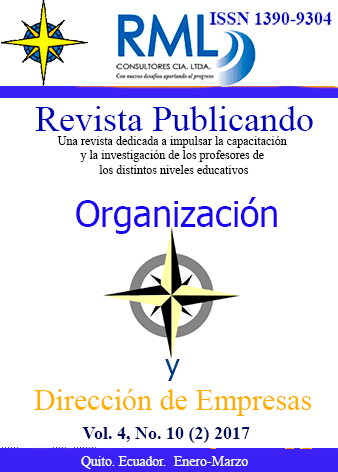Abstract
Los factores que influyen en la innovación han sido objeto de estudio desde diferentes puntos de vista y por distintos autores. Este estudio tuvo como objetivo analizar la incidencia del compromiso organizacional y el comportamiento laboral en los distintos tipos de innovación Empresarial. A efectos de la investigación propuesta se plantea que la Innovación Empresarial abarca los tres tipos de Innovación que se reconocen en la literatura: procesos, productos y servicios.
La importancia de este problema se justifica por la actualidad científica e igualmente porque el problema tiene gran significación práctica para las empresas latinoamericanas obligadas a enfrentar el reto de la globalización a partir del desarrollo de la innovación. En particular para el caso de Ecuador, en que se ha formulado una política nacional que propende hacia el cambio de la matriz productiva, la investigación propuesta puede encontrar un terreno propicio y servir de base para analizar de forma efectiva como puede manejarse el compromiso organizacional y el comportamiento laboral en el desarrollo de los distintos tipos de innovación.
References
Alfalla-Luque, R., Marin-Garcia, J. A., et al.Medina-Lopez, C. (2015). An analysis of the direct and mediated effects of employee commitment and supply chain integration on organisational performance. International Journal of Production Economics, 162, 242-257. doi: http://dx.doi.org/10.1016/j.ijpe.2014.07.004
Arazi, M. C., et al.Baralla, G. (2012). La situación de las pymes en américa latina. Inter-American Development Bank (IADB).
Co-operation, O. f. E., et al.Development. (1997). The measurement of scientific and technological activities: Proposed guidelines for collecting and interpreting technological innovation data: Oslo manual: OECD.
Communities, S. O. o. t. E. (2005). Oslo manual: Guidelines for collecting and interpreting innovation data: Publications de l'OCDE.
de Pablos-Heredero, C., Botella, J. L. M., et al.LosSantos, I. S. (2012). The effectiveness of open innovation practices: An application to efficient replenishment. Procedia Technology, 5, 133-140. doi: http://dx.doi.org/10.1016/j.protcy.2012.09.015
Einolander, J. (2015). Evaluating organizational commitment in support of organizational leadership. Procedia Manufacturing, 3, 668-673. doi: http://dx.doi.org/10.1016/j.promfg.2015.07.300
Esterhuizen, D., Schutte, C. S. L., et al.du Toit, A. S. A. (2012). Knowledge creation processes as critical enablers for innovation. International Journal of Information Management, 32(4), 354-364. doi: http://dx.doi.org/10.1016/j.ijinfomgt.2011.11.013
Genis-Gruber, A., et al.í–ÄŸí¼t, H. (2014). Environmental factors affecting innovation strategies of companies: Customers and suppliers effect. Procedia - Social and Behavioral Sciences, 150, 718-725. doi: http://dx.doi.org/10.1016/j.sbspro.2014.09.033
Gunsel, A., Siachou, E., et al.Acar, A. Z. (2011). Knowledge management and learning capability to enhance organizational innovativeness. Procedia-Social and Behavioral Sciences, 24, 880-888.
López-Nicolás, C., et al.Meroño-Cerdán, í. L. (2011). Strategic knowledge management, innovation and performance. International Journal of Information Management, 31(6), 502-509. doi: http://dx.doi.org/10.1016/j.ijinfomgt.2011.02.003
Martín-de Castro, G., Delgado-Verde, M., Navas-López, J. E., et al.Cruz-González, J. (2013). The moderating role of innovation culture in the relationship between knowledge assets and product innovation. Technological Forecasting and Social Change, 80(2), 351-363. doi: http://dx.doi.org/10.1016/j.techfore.2012.08.012
Ologbo, A. C., et al.Nor, K. M. (2015). Knowledge management processes and firm innovation capability: A theoretical model. Asian Social Science, 11(18), 10.
Oslo, M. d. (2005). La recogida, guía para, e. Interpretación de, and datos sobre innovación.
Parga-Dans, E., Martín-Ríos, C., et al.Criado-Boado, F. (2013). La innovación organizativa y de gestión como motor de dinamización empresarial. Journal of technology management & innovation, 8(2), 132-143.
Scaringella, L., et al.Burtschell, F. The challenges of radical innovation in iran: Knowledge transfer and absorptive capacity highlights ”” evidence from a joint venture in the construction sector. Technological Forecasting and Social Change. doi: http://dx.doi.org/10.1016/j.techfore.2015.09.013
SENPLADES. (2012) Transformación de la matriz productiva. SENPLADES.
Svetlik, I., Stavrou-Costea, E., et al.Lin, H.-F. (2007). Knowledge sharing and firm innovation capability: An empirical study. International Journal of manpower, 28(3/4), 315-332.
Turró, A., Urbano, D., et al.Peris-Ortiz, M. (2014). Culture and innovation: The moderating effect of cultural values on corporate entrepreneurship. Technological Forecasting and Social Change, 88, 360-369.
Vaccaro, A., Parente, R., et al.Veloso, F. M. (2010). Knowledge management tools, inter-organizational relationships, innovation and firm performance. Technological Forecasting and Social Change, 77(7), 1076-1089. doi: http://dx.doi.org/10.1016/j.techfore.2010.02.006
Vargas, M. I. R. (2015). Determinant factors for small business to achieve innovation, high performance and competitiveness: Organizational learning and leadership style. Procedia - Social and Behavioral Sciences, 169, 43-52. doi: http://dx.doi.org/10.1016/j.sbspro.2015.01.284
Vashishta, D., et al.Chadichal, S. S. (2012). An empirical study on innovative business strategies - key to progress in the emerging economies with special reference to yes bank. Procedia - Social and Behavioral Sciences, 37, 504-513. doi: http://dx.doi.org/10.1016/j.sbspro.2012.03.315
Yí¼cel, Ä°. (2012). Examining the relationships among job satisfaction, organizational commitment, and turnover intention: An empirical study. International Journal of Business and Management, 7(20), 44.
You are free to:
Share — copy and redistribute the material in any medium or format.
Adapt — remix, transform, and build upon the material.
The licensor cannot revoke these freedoms as long as you follow the license terms.
Under the following terms:
Attribution — You must give appropriate credit, provide a link to the license, and indicate if changes were made. You may do so in any reasonable manner, but not in any way that suggests the licensor endorses you or your use.
NonCommercial — You may not use the material for commercial purposes.
ShareAlike — If you remix, transform, or build upon the material, you must distribute your contributions under the same license as the original.
No additional restrictions — You may not apply legal terms or technological measures that legally restrict others from doing anything the license permits.
